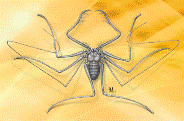Papers in the Biological Sciences

Eileen Hebets Publications
Document Type
Article
Date of this Version
2019
Citation
Oecologia (2019) 191: 61-71. doi: 10.1007/s0044 2-019-04488 -9.
Abstract
Sexual size dimorphism (SSD) often results in dramatic differences in body size between females and males. Despite its ecological importance, little is known about the relationship between developmental, physiological, and energetic mechanisms underlying SSD. We take an integrative approach to understand the relationship between developmental trajectories, metabolism, and environmental conditions resulting in extreme female-biased SSD in the crab spider Mecaphesa celer (Thomisidae). We tested for sexual differences in growth trajectories, as well as in the energetics of growth, hypothesizing that female M. celer have lower metabolic rates than males or higher energy assimilation. We also hypothesized that the environment in which spiderlings develop influences the degree of SSD of a population. We tracked growth and resting metabolic rates of female and male spiderlings throughout their ontogeny and quantified the adult size of individuals raised in a combination of two diet and two temperature treatments. We show that M. celer’s SSD results from differences in the shape of female and male growth trajectories. While female and male resting metabolic rates did not differ, diet, temperature, and their interaction influenced body size through an interactive effect with sex, with females being more sensitive to the environment than males. We demonstrate that the shape of the growth curve is an important but often overlooked determinant of SSD and that females may achieve larger sizes through a combination of high food ingestion and low activity levels. Our results highlight the need for new models of SSD based on ontogeny, ecology, and behavior.
Included in
Animal Sciences Commons, Behavior and Ethology Commons, Biology Commons, Entomology Commons, Genetics and Genomics Commons


Comments
Copyright 2019, Springer-Verlag. Used by permission.